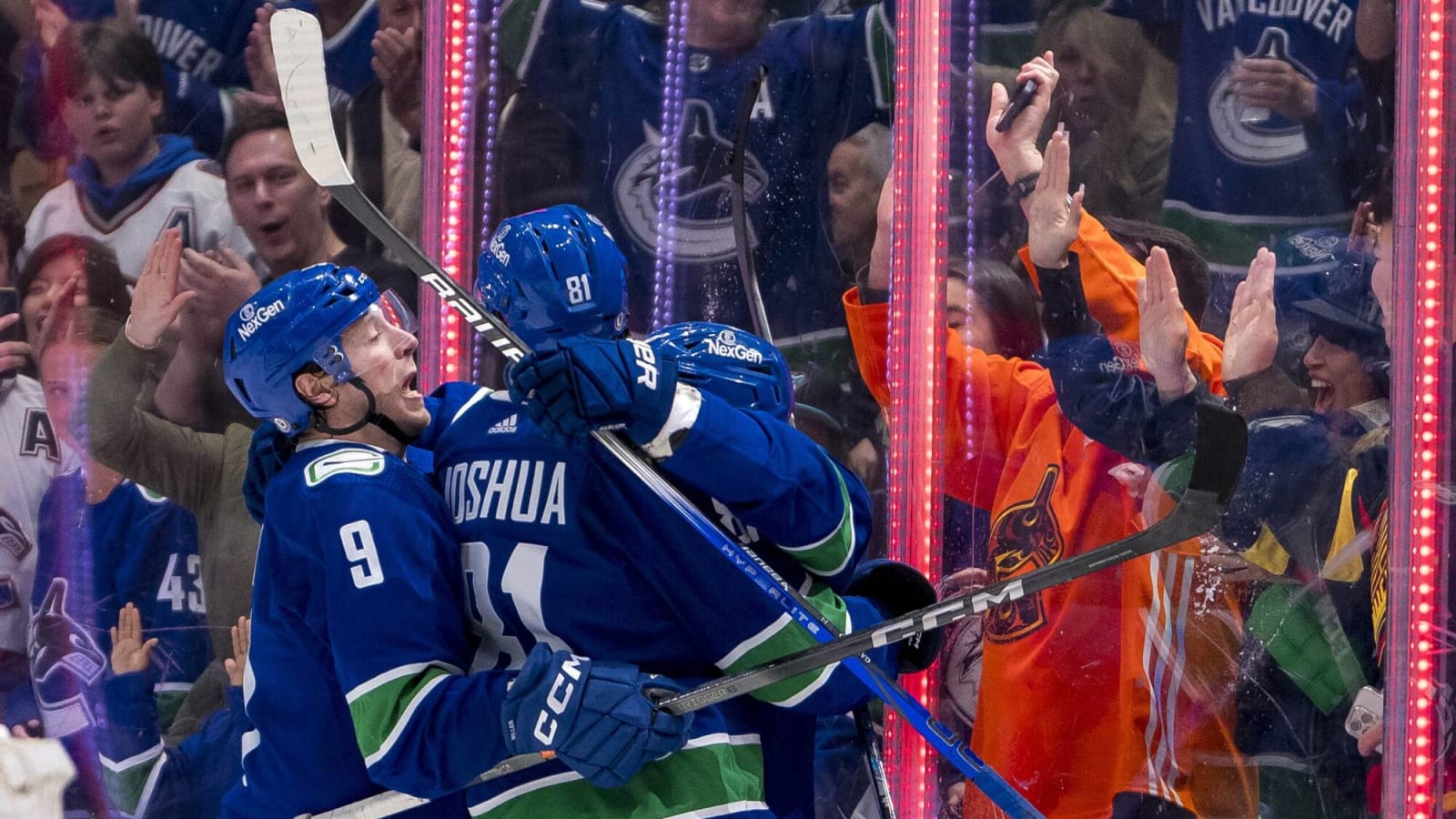
The Vancouver Canucks debuted a new scoring line on Sunday afternoon against the Anaheim Ducks, and the immediate returns were extremely positive.
Wingers Conor Garland and the recently-returned Dakota Joshua traded in their usual centre for a clear-cut upgrade in JT Miller. The result was two goals from Joshua, including the game-winner, two assists from Miller, and one from Garland.
And as good as that production sounds, their actual level of play on the ice was perhaps even better than raw goals and assists might indicate. According to the fancy stats, the Joshua-Miller-Garland line racked up a 67.74% Corsi against Anaheim, a 65.45% share of expected goals, and an even 70.0% control of high-danger chances.
All while being matched up against the best defensive players the Ducks had to offer.
The breaking up of Miller and Brock Boeser also allowed the Canucks to throw together another brand-new top-six configuration for the previous game against Dallas in the form of a Nils Höglander-Elias Pettersson-Brock Boeser unit.
Now, that line has yet to actually score since being put together. But that doesn’t mean that their results have been poor. Much the opposite. In fact, despite being held pointless against Anaheim, the new Pettersson line posted slightly better analytics than the Miller line, with a 68.42% Corsi, a staggering 76.14% share of expected goals, and a simply dominant 100.0% share of high-danger chances (albeit, there were only two.)
All that, in 30 more seconds of even-strength ice-time against relatively equal competition.
The Canucks have been looking for the winning combination to their top-six virtually all season long. For much of the year, it was hard to look at it as a serious concern, what with the Canucks being the top-scoring team in the entire league. But they’ve slipped down the rankings of late, now down to sixth overall in goals-per-game, and as the playoffs approach, there is perhaps a desire to nail down some lines so that they can begin to build up chemistry.
And perhaps the best solution is what we saw on the ice on Saturday, and as simple as building a top-six forward corps out of the team’s top six forwards.
Straightforward enough, no?
If one sorts by points-per-game, they’ll find that the top six Canucks forwards are the exact same sextet that occupied the top-six against Anaheim: Miller, Pettersson, Boeser, Garland, Joshua, and Höglander, in that order (though it’s worth noting that Andrei Kuzmenko still technically outranks Höglander.)
If the Canucks are looking for a top-six that is maximally effective, there’s no better place to start than with the six most effective and productive individuals, especially if they’ve landed upon a configuration that works.
Breaking up Miller and Boeser is tough. They’ve been attached at the hip since October, and the result has been the best season in either player’s career. But there’s been a desire all year long to find a winger who really “works” with Pettersson, and no winger has ever worked better with him than Boeser.
Miller, meanwhile, is a versatile player who can find success pretty much anywhere. Placing him at the centre of perhaps the two best play-controllers on the forward corps is an excellent fit, and essentially equates to more time in the offensive zone for Miller – more time during which he’s not necessarily the center of attention. Joshua and Garland’s chemistry with one another is apparent, and doesn’t really require Teddy Blueger in the middle. The team’s top scorer will do just fine as a replacement.
Throw in the burgeoning chemistry between Pettersson and Höglander, and suddenly, we’ve got the makings of a top-six that might really “click,” and not a moment too soon.
There are also potential benefits throughout the rest of the lineup.
Assuming that Elias Lindholm can return to the ice prior to or right at the outset of the playoffs, the Canucks now have the pieces in place for a dynamic and dynamite two-way third line, featuring Lindholm and Pius Suter swapping centre duties back-and-forth and perhaps accompanied by Ilya Mikheyev. None of those players have found consistent success in the top-six, but each probably qualifies as “better than the average third liner.”
This would be a third line that could reasonably be thrown out there in any game situation, as well as one that should be expected to provide timely offensive contributions.
That leaves a likely fourth line of Blueger between a combination of, say, Vasily Podkolzin and Sam Lafferty, which sounds line a darn fine defensive energy unit.
Obviously, things won’t stay nearly that static. Shuffling will happen, injuries will occur, and head coach Rick Tocchet will make changes accordingly.
But in the current set-up, the Canucks at least have the makings of a set of line combinations with some potential staying power. And over the course of the final eight games on the season, there might be some serious impetus to stick with them, if for nothing else than the benefit of heading into the postseason with the top-six on something of a roll.
In the end, the answer to the top-six “issue” might have been hiding in the label all along. If it’s as simple as just playing the top six forwards together, then it’s a solution that the Canucks seem to have stumbled upon as of the Anaheim game.
Now we see how far that chemical momentum can be carried forward.
More must-reads:
- Lightning reportedly extend HC Jon Cooper
- NHL announces 2024 Norris Trophy finalists
- The 'NBA Coach of the Year' quiz
Breaking News
Customize Your Newsletter
 +
+
Get the latest news and rumors, customized to your favorite sports and teams. Emailed daily. Always free!

